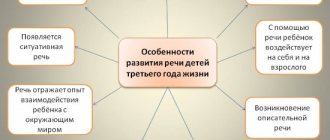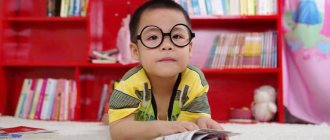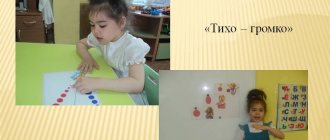Modern parents know that in order to successfully study at school, children need to clearly and clearly pronounce all the sounds of their native language. Without correct speech, it is impossible to express your thoughts, write dictations, or compose retellings. Usually, by school, a child should have well-developed speech. However, some preschoolers never learn to speak clearly and distort some sounds, so it becomes necessary to consult a speech therapist. Experts note that recently new types of dyslalia (sound pronunciation disorders) have appeared, which were almost never encountered before. These include incorrect pronunciation of the sounds T, D. Will parents be able to work on correcting sound pronunciation at home if such a speech disorder is discovered in a child? In order to properly organize classes at home, you need to understand what the production of the t sound is in connection with the production of the d sound.
Important: correct pronunciation develops mainly by the age of five, so you should seek special help after 5 years. However, from an early age it is necessary to carefully monitor the child’s speech, not to be touched by the distortion of words, but, if possible, to correct the child’s speech errors.
Features of articulation of the posterior lingual and types of disorders
When pronouncing K, the lips take the form of the subsequent vowel or half-smile, the teeth are open. The tip of the tongue is located at the bottom, and itself is shaped like a slide. The back of the backrest should touch the back of the roof of your mouth.
The lateral edges of the tongue should be pressed against the upper lateral teeth. When you say K, the vocal cords are not working, they are not closed. The exhalation must be strong in order to open the closure that forms between the back of the tongue and the palate.
The incorrect pronunciation of this sound is called cappacism, and its replacement with another is called paracappacism. There are several types of these violations:
- Instead of K, a guttural click is obtained. It is formed as a result of the fact that the vocal cords close, and during breathing there is additional pressure on them. When the child says K, the air comes out with a noise, which adds a guttural click.
- In speech there is a replacement with T.
- Replaces with X.
If there are any of these disturbances in speech, it is necessary to conduct a diagnosis and correct the sound pronunciation.
How do sound pronunciation disorders manifest themselves?
If the baby pronounces sounds incorrectly, this may indicate dyslalia or dysarthria. These deviations have some differences. With dyslalia, the pronunciation of sounds of different groups is impaired - sonorant, hissing, front-lingual, and so on. Speech defects can manifest themselves in different ways:
- absence of sounds (omission of complex letters in the words “yoke” - “yoke”);
- replacing sounds (together with “R” the child pronounces “L”, for example “fish” - “lyba”);
- distortion of sounds (French “R”, side “W”, etc.).
Dyslalia often develops against the background of hearing loss. Children with hearing loss have difficulty distinguishing between whistling and hissing, dull and voiced sounds.
With dysarthria, the child pronounces consonants and vowels incorrectly. Improper breathing and decreased emotional expressiveness of speech are also observed. It is worth noting that disturbances in the pronunciation of sounds associated with dysarthria are more stable. Therefore, correction may require more time and effort.
Reasons for violations
Children usually learn to pronounce correctly through onomatopoeia. But if there are deviations in the structure and operation of the articulatory apparatus, then the pronunciation of a certain sound group (or several) will be impaired. In the case of cappacism, this is an irregular shape of the hard palate, which causes difficulty in forming the bow necessary for correct articulation.
In addition, the cause may be weak or increased muscle tone of the tongue. Then the tongue cannot occupy or hold the desired position, which also affects pronunciation. The reason for the appearance of paracappacisms is the insufficient formation of phonetic-phonemic processes.
These types of sound pronunciation disorders may be signs of the following speech disorders:
- dyslalia - simple and complex forms;
- dysarthria;
- rhinolalia;
- alalia.
If there is a complex speech disorder, then it is necessary to provide comprehensive assistance, which includes not only sessions with a speech therapist, but also with a speech pathologist, and a consultation with a neurologist.
Mechanical dyslalia
Mechanical or organic dyslalia is caused by structural features of the speech apparatus, such as:
- shortened frenulum of the tongue;
- thick and large tongue;
- small and narrow tongue;
- high narrow (Gothic) or, on the contrary, too low palate;
- malocclusion, in which the sound formation of individual phonemes becomes difficult or, in some cases, even impossible;
- an upper or lower jaw that is too forward, a gap between the teeth or between the jaws;
- sometimes the inability to pronounce sounds is also influenced by the weakness of the air stream necessary for the formation of sounds that are especially difficult for children - r and l.
Most often, with mechanical dyslalia, the speech therapist recommends that the bite be corrected by an orthodontist, if possible. This is best done at the age of 5-6 years, when the joints are most flexible.
Diagnostics of sound pronunciation
The speech therapist evaluates sound pronunciation, looks at the state of the articulatory apparatus and phonemic processes. First, the specialist studies the anatomical structure of the articulation organs, then evaluates their work. To do this, the speech therapist asks to perform exercises to maintain a certain position, gives tasks for motor skills (raise and lower the tongue, show the horse, etc.).
Then the specialist asks the child to say the desired sound. First, he pronounces it without combination with other sounds, in syllables with vowels and other consonants. Then in words, phrases, sentences, coherent speech. In tasks for assessing coherent speech, you need to compose a story based on a picture, talk about your favorite toy or cartoon, or on any other topic.
The purpose of tasks for phonetic-phonemic perception is whether the child distinguishes K in the speech stream and does not confuse it with sounds similar in acoustic characteristics. The speech therapist pronounces different sounds, the child needs to select the one he needs. Then the material is complicated - they pronounce it in words, syllables. An adult can ask you to name all the objects that contain K. A good task is to distribute the pictures into groups for a specific sound.
The specialist pays attention to the speech environment in which the child grows up. If one of the adults around him has kappacism or parakappacism, then either he also needs to correct his pronunciation, or try to use fewer words with the sound K when communicating with the baby.
Delayed speech development: how to help your child speak
Delayed speech development is one of the most pressing problems in pediatric neurology today, which, unfortunately, also affects absolutely healthy children. Often the parents themselves are the cause of a child’s speech difficulties. The chief pediatric neurologist of the Ministry of Health of the Tver Region, Galina Anatolyevna Zueva, tells what to do and what should not be done under any circumstances so that the child speaks correctly and on time.
Hello, dear parents!
Today our conversation is devoted to a very important and pressing problem - the speech development of children. In the last few years, we have increasingly heard that a child who is not speaking at 2.5-3 years old is a variant of the norm, that there is nothing wrong with this, you just need to wait a little, and speech will appear. In fact, this approach is fundamentally wrong. There are physiological norms for proper speech and mental development, and it is very important to monitor their compliance from the very birth of the child. Only in this case will he be able to develop harmoniously and fully.
The main stages of child speech development
You can start developing your baby’s speech from the first day of his birth.
The first thing you need to pay attention to is how the baby cries. A baby’s cry from birth is very different, it becomes especially expressive in the first month of life, from it you can understand what the baby needs: he is cold, he is in pain, he wants to eat or go to the toilet, or maybe he just wants his mother to hold him in his arms. . If the child does everything correctly intonationally, then an attentive mother quickly learns to understand the difference and respond to these “requests.” In this case, mental and then speech development occurs harmoniously. If your child cries monotonously, at the same level, and does not respond well to the voice, consult a doctor.
If the child is healthy and has no hearing problems, then in response to positive emotions in the second month of life he begins to “walk.” Along with the “humming”, the first laughter appears - squealing in response to emotional communication with an adult. The sounds of “humming” are already distinguished by a certain variety with a predominance of combinations of guttural and vowel sounds (“gu”, “ge”, “ha”, etc.) With these sounds he tries to communicate, reacts to what is happening around him. If the baby does not start to “walk”, consult a doctor; perhaps he has a problem with his ears.
At two months, the period of onomatopoeia begins: the baby carefully follows his mother’s lips when she talks to him, and seems to be trying to repeat these movements, but so far silently. So, by 3.5-4 months, a true “humbling” is formed, where the child focuses on the pronounced sound, syllable, as if listening to himself. During the period of true “humming,” the sounds become longer, melodious, and more varied. Along with laryngeal and vowel sounds, labial sounds and combinations of vowels and labials are increasingly appearing.
By six months, the child develops babbling speech - he begins to pronounce some individual letters and syllables. During this period, it is important to monitor intonations - how he speaks, how he cries. At six months, a healthy child should already be chatting, pronouncing certain syllables, and repeating specific sounds after his mother. During the period of babbling, imitation of the sounds of an adult becomes more distinct.
By the end of the pre-speech period, the child’s nonverbal forms of communication with others become more complex. Communication is carried out using both hands, more differentiated facial expressions and sounds. The child reaches out his hands to his mother, utters separate sounds, as if asking “take me.” Then facial expressions become more complex. She becomes more expressive, symbolic gestures appear. The child can communicate using one hand. Babbling words of various intonations appear.
By the age of one year, a child should speak from 8 to 10 simple words: “mom”, “dad”, “baba”, “give”, “na”, that is, short simple words of several syllables. It is during this period that early speech development ends and motor speech begins to form as a way of communication between people.
After one and a half years, a child easily pronounces familiar and unfamiliar words by imitation, both addressed to him and accidentally heard from others. Intensive development of motor speech usually begins in the second half of the 2nd year of life. Until one year and six months, a child pronounces about 30 words with simple sound composition. At two years old, a child already speaks more than 200 words, he has almost phrasal speech, he should already be able to formulate a simple thought or request: “Mom, let’s go to the store, you promised to buy me a toy.” However, he may still pronounce some sounds unclearly. By the age of three, a child’s speech contains up to 1200-1500 words, including almost all parts of speech.
This development is considered normal. But this happens only when the parents constantly talk to the child, tell him fairy tales, and sing lullabies. A very big problem today is that live speech is increasingly being replaced by gadgets. Because of this, many children who were initially born healthy from a neurological point of view do not begin to speak in time.
If a healthy child at 2.5-3 years old does not speak phrasal speech at all and, at best, only speaks a few simple words, he has a delay in speech development, and this, unfortunately, must be treated.
Speech develops gradually
It takes time for a child to learn to speak correctly and construct logical, figurative phrases. When a child is just learning to walk, he takes his first hesitant steps with his mother’s help, and after six months to a year he is already running, jumping and dancing on his own. The same thing happens with speech: it develops gradually. The child not only remembers new words, but also at the same time trains articulatory muscles and learns to control intonation. This takes more than one year. Therefore, if at 3-3.5 years old your child is just beginning to pronounce the first words and construct the simplest phrases like “Mom, give me”, then by the age of six, when it’s time to go to school, he will not have developed full-fledged phrasal speech. It is important to develop speech gradually, but from a very early age.
Causes of delayed speech development
The first and most basic reason is brain damage due to ischemia, hemorrhage, and infection. But such deviations are immediately diagnosed, doctors monitor the child and take all necessary measures. These are the patients with whom a neurologist, psychologist and speech therapist are already working.
But there is a category of patients who are born absolutely healthy. But due to errors in learning, they also begin to experience delays in speech development. Most often, the reason is parents’ excessive fascination with mechanical sound, that is, sound from a TV, computer, tablet, phone. Children who watch a lot of cartoons or constantly play with singing-talking toys develop passive speech well, but their own active speech is not formed. This occurs due to the difference in wavelength between live speech and mechanical speech. In order for a child to start talking, you need to talk to him as much as possible, read fairy tales yourself, and sing lullabies.
Under no circumstances should a TV or radio be allowed to work in the background in the room where the baby spends time. Of course, if you want to show your child some cartoon or program on the computer, this can and should be done, but after watching the device you need to turn it off and put it away.
Of course, all these devices and toys allow mom to relax a little or do some of her own business. But when they replace live communication, this leads to serious problems with the child’s psyche. It’s better to prevent such things from happening than to have to spend years catching up. To restore the correct speech pattern in a three-year-old child, to change his perception, a lot of effort and time is required: the child cannot quickly catch up with such gaps, he has to resort to intensive drug treatment, and additional classes with speech therapists. This is a long and difficult path. Why bring it to this point if you can do everything right from the very beginning?
Why you need to sing lullabies
Singing lullabies is an important part of raising a child. The most famous lullabies, for example, “bayu-bayushki-bayu,” were invented back in the 5th-6th centuries, and it is no coincidence that we still sing them to children. They are built specifically in the timbre and wavelength fluctuations that are understandable to the child, calm him, and develop the brain. Each age has its own songs that need to be sung. Humming such lullabies to a small child and simultaneously rocking him in your arms creates the basis for proper mental development.
Nowadays, many couples approach pregnancy planning with full responsibility: they lead a healthy lifestyle, undergo all tests, read books about the health and raising of the unborn child. Include in this preparation and learning at least a few lullabies to sing to your baby. No matter how simple they may seem to you, they contain folk wisdom that has been proven over centuries for the correct development of personality, this is very important. Sing these lullabies for at least a year.
By the age of two, when the child already understands phrasal speech well, songs can be selected that are more plot-based, so that while the mother sings, he can imagine this picture in his head.
Talk to your child as much as possible
Don’t rush into conversations with your baby, calmly and measuredly tell him what’s happening around him, voice your actions. Then he will begin to perceive by ear the name of this or that object, and this is how passive speech is formed. From six months onwards, add details about the color and volume of objects: “small toy”, “red ball”. When you do this constantly, the child learns to hear and understand you.
This helps to explain to the baby after a year that panties should be dry, that is, it is quite early to potty train the child, and not use diapers all the time. At one and a half years old, the child is able to hold the bladder and control his pelvic functions. This is one of the important links in mental development. Of course, he will eventually learn to ask to go to the toilet himself, but these skills will come much later and not in the form in which he would like.
Therefore, it is very important to accustom yourself to talk to your baby as much as possible and limit mechanical sounds around him as much as possible - these are the most important parts of preventing speech development delays. If we build this correctly, then at the age of 2.5 years the child begins to speak in phrasal speech, and parents have no problems with his behavior or learning. If your child at 2.5 years old does not speak, especially if there is no so-called gibberish speech, he is silent and does not voice the game, a request addressed to you for something, then this is not a variant of the norm, this is a problem that needs to be dealt with.
How to talk to a child
- You need to talk to your child in a normal timbre; it is your tone and timbre that the child knows from his prenatal state.
- Try to speak in simple phrases, but do not lisp or distort words.
- If a child has a problem with vision or hearing, then the mother needs to start brightly painting her lips as early as possible so that he can watch her lips and understand exactly how she pronounces sounds.
- If a child had problems with swallowing in the first year of life, then, unfortunately, problems with sound pronunciation cannot be avoided. You can start working with a special speech therapist already in the first months of the baby’s life, even in the pre-speech period.
- Solve all problems as soon as they appear, do not put it off and do not wait for it to go away on its own. It won't work.
Is it a speech therapy garden or a regular one?
So, the child has grown up, and it’s time to decide which preschool institution to take him to. At this moment, it is important to figure out whether your baby has mental and speech problems, and what they are.
When the baby does not have any serious medical problems, start with a regular kindergarten. If in the first year your speech does not level out and develop to the required level, then you should apply for a medical-pedagogical commission. It runs from February to June. You can get a referral from a preschool or call them and make an appointment. To pass the medical-pedagogical commission, you must have a conclusion from a neurologist, speech therapist, or psychiatrist about the state of your child’s health.
If a child begins to speak in phrases, but does not pronounce certain sounds, then you can take him to a regular kindergarten that has speech therapy groups. There they work with children with normal psycho-speech development, but with incorrect settings for the sounds themselves. Typically, a speech therapist begins working with such children at the age of five in order to improve their speech and correct all weak sounds before school. On average, it takes three months to set and consolidate one sound.
One of the common disorders in children 3-3.5 years old is the so-called porridge in the mouth, when, due to a violation of the innervation of the speech muscles, the child cannot pronounce some sounds clearly and clearly. In this case, you cannot do without the help of a specialist; it is better to contact a neurologist to determine the exact cause of dysarthria and carry out the necessary treatment, if necessary; you also need to visit a special speech therapy garden. This requires an integrated approach: simultaneous coordinated work of a speech therapist, neurologist and psychologist.
The distribution of children into specialized groups or kindergartens is carried out by a medical-pedagogical commission.
And again, I repeat, it is much easier to prevent speech development delays, so that those children who could speak, but did not start due to lack of parental attention, do not end up in special groups. To do this, it is important not just to talk with the child, but to hear what he is talking about, try to understand him and respond to his words. I assure you, if you establish this contact from childhood, it will last a lifetime and will help your child become a good member of the family, society, reliable support and support for you.
How to prevent stuttering
There are times when a child does not begin to speak for a long time, but at the same time they work with him, he accumulates a large passive vocabulary, and can compose phrases in his head. If you start his speech process too actively, he will not be able to cope with the flow of speech and will begin to stutter. Most often this happens at 2.5-3 years. Children with tics (obsessive blinking, blinking, sniffing, etc.) are especially susceptible to stuttering. If you notice that the child begins to stammer at the beginning of speech, this is a signal that you need to contact a neurologist to solve the problem. Of all obsessive disorders, stuttering is the most difficult problem, which can take years to treat.
The pacifier and the child's speech development
Another important aspect of preventing speech delay is prolonged use of pacifiers and prolonged breastfeeding. I mean the situation when a pacifier or mother’s breast is in the child’s mouth not for soothing or feeding, but just like that, in a state of wakefulness. In this case, the problem arises purely mechanical: in order to speak, the mouth must be free, but if the mouth is busy, then it is impossible to speak - the nipple or breast is in the way.
The pacifier can be used when the child falls asleep, when he is sick, or when he hits himself, but it must be removed while he is awake. After two years, the pacifier should be completely abandoned. This will help avoid speech problems and maintain proper bite, which will significantly reduce your financial costs in the future when an orthodontist treats your beloved child’s unsightly teeth.
The same applies to the mother's breast. It should be a source of food or a means of calm, nothing more. Of course, breast milk contains a lot of good substances, but it is needed only until the child begins to eat normal human food. Breast sucking is very important for the formation of psychological communication between mother and child. But by the age of two, the child already understands spoken speech well and can speak himself, so this connection only strengthens and will not be interrupted in any way after the child is weaned.
It is important to wean your baby from thumb sucking from the very beginning. By the age of 2.5-3 years, the child should be comfortable without a pacifier, mother's breast, or thumb sucking. Why? During sucking, rocking-forward movements give a feeling of calm and sedation. With age, the child’s need for such movements weakens; now he needs to explore the world around him and be active. And if a child continues to suck a finger or a pacifier, then he automatically transfers himself to the infant period, behaves like a baby and does not give himself the opportunity to fully develop.
Gadgets: harm or benefit
Modern devices, on the one hand, are very useful, but when it comes to children, you need to be extremely attentive and careful. Nobody says that you shouldn’t use TV and gadgets at all. This is an important part of modern life, children should be able to master them. But a small child does not yet have the skills of speech, movements, motor skills, proper mental development, criticism, self-criticism, and the ability to control oneself are incorrectly formed. Therefore, it is very dangerous to uncontrollably give him something that can provoke abnormal development.
In Russia, little is said about this, and today in most families gadgets are used beyond the permissible limit; for each family member, including an infant, there are from two to three gadgets. At the same time, in the same high-tech Japan, children are allowed to use a telephone or computer only from the age of five, when the nervous system has matured. And I agree with their approach. Yes, you can turn on some educational games or cartoons for your child, but no more than 30-40 minutes a day on a good screen with good sound. It is better to avoid tablets and smartphones, because young children quickly develop color and tactile addiction.
Into the wilderness, into the village
Finally, I would like to advise all parents to spend more time with their children outdoors. This will be especially useful for children who have problems with psycho-speech development. The best thing is to go to the countryside for several weeks or even months, where there are only living sounds of nature from a running stream, the rustling of leaves on trees, the buzzing of a bee and other sounds, where there is no urban, mechanical sound from the hum of wires. This will not only help normalize sleep and give peace of mind, but will also give the child’s brain overloaded with information the opportunity to rest and gain strength to overcome all difficulties in speech development.
Be healthy! Good luck to you and your children!
Staging methods
The easiest way to stage it at home is by onomatopoeia. To do this, ask your child to cough (cough). You should open your mouth wide so that your baby can see the correct articulation. You need to cough with a small exhalation so that there is no pronounced X between K and E.
Then offer to cough in a whisper. This will help remove the X sound, the result should be the syllable KE. Practice this syllable, then invite your child to combine it with other vowels. Try speaking the sound in isolation.
But the onomatopoeic method does not always help in cases of complex speech disorders. For such options, there are other ways to set the back-lingual group of sounds:
- Staging while inhaling. The adult asks to hide the tongue as far as possible. Be sure to show your child how to do this. With this inhalation, you need to pronounce syllables like KA. After practicing, make the task more difficult: inhale like this, and say this syllable as you exhale. When the back-lingual sound becomes clear, practice its pronunciation in isolation.
- Mechanical method. For this you need a speech therapy spatula. Ask your baby to pronounce the syllables TA-TA-TA. You press the tip of your tongue with the spatula and gently push it deep into your mouth. Before doing this, be sure to warn your child about what you will do and ask him not to remove his tongue. When you hear a clear K, focus your baby’s attention on its sound. Let the child try to pronounce it without the help of an adult. Of course, he may not be able to immediately pronounce it on his own, and an adult will need to help him. When the child learns to say it on his own, begin to consolidate it in syllables.
These were ways to make the K sound yourself at home. Most often, it can be delivered using onomatopoeia, because the articulation of the back-linguals has the same base. And if a child has one of the sounds of this group, then he will quite easily learn the articulation of other back-lingual sounds.
Parents ask a speech therapist: “The child cannot pronounce the letter K, how can he quickly learn correct articulation?” First, the speech therapist sets up sounds and letters are taught in literacy classes. Secondly, the duration of correctional work depends on the speech disorder and the individual characteristics of the child.
Features of pronunciation of sounds T D
What typical mistakes do children make when pronouncing them? Systematically occurring speech disorders include:
- Replacing the front-lingual sounds “T – D” with the corresponding back-lingual “k – g”, for example, “k( t )igrenok”, “ing( d )yuk”.
- Mixing the front-lingual consonants “T – D” with the back-lingual “k – g”: cell - cell; glass - rolled.
- The sound “T” can be softened by “P” or “K”, for example: pichka - bird; drink, drink instead of dot.
- Persistent confusion T H (u t it - teaches, nine ( h)ka), T Ts (Pet ya - Petya, blooms - blooms).
In children with speech errors, one can observe the following construction of sentences: “Mom, where (where) are my tanfettes (sweets)?”, “There are sweets on the tartine (picture). Others immediately notice such violations, and parents may also detect incorrect articulation of the sound t : instead of leaving the tip of the tongue below, resting on the front teeth, the baby raises it to the palate.
Very often the reasons for incorrect pronunciation are:
- Disturbances in articulation (function of the speech organs).
- Low mobility of the lower jaw.
- Underdevelopment of auditory perception (the baby cannot distinguish sounds).
- It’s a bad example for adults when someone around them pronounces T D .
In any case, the diagnosis is made by a speech therapist, and parents are engaged in making sounds at home in accordance with his recommendations. Articulation gymnastics is very helpful in work, which should become a constant companion not only in classes, but also in everyday life.
Important: correction of the pronunciation of sounds N T D, as a rule, is carried out after simple sounds are clearly defined in the preschooler’s speech: vowels (a, u, o, i, e, s) and consonants (b b, p p, m m, v v, f f).
To examine the pronunciation of T D , you can offer your child a small test in the form of several exercises:
- Following the adult, pronounce sentences in which these sounds occur, for example: Dusya gives melon to Dasha. Aunt Tanya has notebooks on the table.
- Look at pictures that depict objects with sounds T D , for example: slippers, calf, tiger, axe, TV, cart, cake; melon, house, door, tree, girl, children.
- Among the pictures laid out on the table, find the one that the adult names: dot - daughter, cloud - dacha, duck - pipe, pond - twig, house - volume.
Work is required for the child whose speech cannot be traced with TD or is replaced by other sounds, and there is no differentiation (distinguishing sounds that are similar in sound).
Recommendations for parents on automation and differentiation
Once you have established the correct pronunciation, you need to reinforce it in your speech. You need to start working on automation with something simple - with syllables, gradually complicating the speech material to compiling stories and retellings. If, in addition to cappacism, the child has paracappacism, then when choosing words for reinforcement, be careful: the words should not contain sounds that are similar in acoustic characteristics.
The child says T instead of K - this is one of the most common forms of paracapacism. In general, replacing one sound with another may be due to the absence of one of them. At the differentiation stage, be sure to talk through the articulation of mixed sounds with your child and focus on their differences.
To differentiate, start with isolated pronunciation. When the child can accurately identify the desired sound, complicate the speech material. But the mixed sounds must be in a strong position so that the child can hear them clearly. This stage needs to be worked out only when the child’s sound pronunciation is corrected and the stage of automation in syllables and words is underway, then the correction work will be effective.
Corrective work
If a child pronounces sounds incorrectly, you should contact a speech therapist. He will examine the baby, determine the cause of the disorder and prescribe an effective assistance program. It is selected individually in each case. In order for a child to speak normally, it is necessary to eliminate the cause of the violation of pronunciation of sounds. In some cases, surgical correction of the speech apparatus is required. Then the speech therapist refers the child to the dentist. After this, you can begin to produce the correct speech.
Many parents worry when their child pronounces many sounds incorrectly. In this case, to correct the disorder, it is better to contact the NEAPL Speech Therapy and Psychology Center. Experienced specialists use an integrated approach to correcting speech defects using speech therapy massage, play sessions, logorhythmics, and so on. A team of professionals works on the correct pronunciation of sounds, which allows you to achieve a lasting effect.
Tahilalia
With tachylalia, a pathological acceleration of the tempo is observed, while the child has normal hearing and no pathologies of the speech organs. Speech is fast, incomprehensible, the baby often swallows endings, distorts and repeats words, articulation is changed. Tachylalia is often associated with neurological disorders and can be manifested not only by an accelerated rate of speech, namely:
- the child stammers, swallows words;
- he doesn't have enough air to say the next words;
- moves fussily and quickly;
- has trouble falling asleep, often wakes up;
- there are problems with memory, reading, writing;
- often gets irritated and behaves aggressively;
- has difficulty concentrating on a task;
- attention is scattered.
Children with tachylalia talk non-stop, they do not listen and interrupt their interlocutor, and therefore they have problems communicating with peers and adults.
In some cases, tachylalia is caused by a hereditary predisposition, but often this disorder is explained by damage to the central nervous system due to severe infections, injuries, and certain diseases.
Diagnosis and treatment of tachylalia occurs with the participation of a speech therapist, neurologist and psychologist. If time is not lost, then the overall prognosis is favorable. Tachylalia may return within a year after correction. The most lasting results are provided by group classes with an experienced speech therapist.
Diagnosis of dyslalia by the nature of speech impairment
Diagnosis of dyslalia begins with finding out all the features of the course of pregnancy, childbirth, and illnesses the mother suffered during this period. What matters are the child’s illnesses that he suffered at an early age and his psychomotor development. Other factors also influence the diagnosis:
- features of speech development at an early age;
- hearing;
- vision;
- condition of the musculoskeletal system.
In order for the specialist to have a complete understanding of this, it is recommended to show all available medical documentation. After identifying these factors, the speech therapist proceeds to examine his patient. He examines the articulatory apparatus and determines their mobility. This happens through special exercises and tasks that the child must complete.
The diagnosis of dyslalia includes analysis of sound pronunciation, determination of speech defects, their nature, depth, and degree of complexity. Particular attention is paid to phonetic hearing - the ability to differentiate sounds into groups. The speech therapist’s conclusion indicates the form of dyslalia, the type (articulatory-phonemic, acoustic-phonemic, articulatory-phonetic), and the type of sound pronunciation (rhotacism, sigmatism, etc.).
If you have mechanical dyslalia, consultation with a dentist and orthodontist is required. For functional – a neurologist and analysis on his part. Diagnostics by an otolaryngologist will also be required to examine the hearing aid. The main goal is to accurately determine the child’s condition and the level of development of his speech apparatus. Correct diagnosis is necessary for accurate and correctly selected correction.
Differential diagnosis of erased dysarthria and dyslalia
There are common symptoms of two speech disorders, which can mislead a specialist when making a diagnosis. The table below presents the main characteristic features that will help differentiate erased dysarthria and dyslalia.









